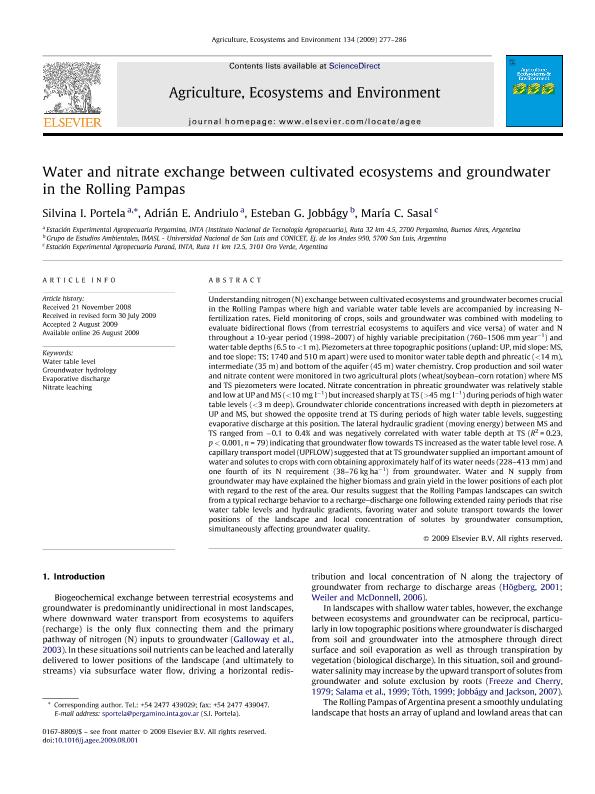Artículo
Water and nitrate exchange between cultivated ecosystems and groundwater in the Rolling Pampas
Portela, Silvina Isabel; Andriulo, Adrian Enrique; Jobbagy Gampel, Esteban Gabriel ; Sasal, María Carolina
; Sasal, María Carolina
 ; Sasal, María Carolina
; Sasal, María Carolina
Fecha de publicación:
01/2009
Editorial:
Elsevier Science
Revista:
Agriculture, Ecosystems and Environment
ISSN:
0167-8809
Idioma:
Inglés
Tipo de recurso:
Artículo publicado
Clasificación temática:
Resumen
Understanding nitrogen (N) exchange between cultivated ecosystems and groundwater becomes crucial in the Rolling Pampas where high and variable water table levels are accompanied by increasing N-fertilization rates. Field monitoring of crops, soils and groundwater was combined with modeling to evaluate bidirectional flows (from terrestrial ecosystems to aquifers and vice versa) of water and N throughout a 10-year period (1998-2007) of highly variable precipitation (760-1506 mm year-1) and water table depths (6.5 to <1 m). Piezometers at three topographic positions (upland: UP, mid slope: MS, and toe slope: TS; 1740 and 510 m apart) were used to monitor water table depth and phreatic (<14 m), intermediate (35 m) and bottom of the aquifer (45 m) water chemistry. Crop production and soil water and nitrate content were monitored in two agricultural plots (wheat/soybean-corn rotation) where MS and TS piezometers were located. Nitrate concentration in phreatic groundwater was relatively stable and low at UP and MS (<10 mg l-1) but increased sharply at TS (>45 mg l-1) during periods of high water table levels (<3 m deep). Groundwater chloride concentrations increased with depth in piezometers at UP and MS, but showed the opposite trend at TS during periods of high water table levels, suggesting evaporative discharge at this position. The lateral hydraulic gradient (moving energy) between MS and TS ranged from -0.1 to 0.4% and was negatively correlated with water table depth at TS (R2 = 0.23, p < 0.001, n = 79) indicating that groundwater flow towards TS increased as the water table level rose. A capillary transport model (UPFLOW) suggested that at TS groundwater supplied an important amount of water and solutes to crops with corn obtaining approximately half of its water needs (228-413 mm) and one fourth of its N requirement (38-76 kg ha-1) from groundwater. Water and N supply from groundwater may have explained the higher biomass and grain yield in the lower positions of each plot with regard to the rest of the area. Our results suggest that the Rolling Pampas landscapes can switch from a typical recharge behavior to a recharge-discharge one following extended rainy periods that rise water table levels and hydraulic gradients, favoring water and solute transport towards the lower positions of the landscape and local concentration of solutes by groundwater consumption, simultaneously affecting groundwater quality.
Archivos asociados
Licencia
Identificadores
Colecciones
Articulos(IMASL)
Articulos de INST. DE MATEMATICA APLICADA DE SAN LUIS
Articulos de INST. DE MATEMATICA APLICADA DE SAN LUIS
Citación
Portela, Silvina Isabel; Andriulo, Adrian Enrique; Jobbagy Gampel, Esteban Gabriel; Sasal, María Carolina; Water and nitrate exchange between cultivated ecosystems and groundwater in the Rolling Pampas; Elsevier Science; Agriculture, Ecosystems and Environment; 134; 3-4; 1-2009; 277-286
Compartir
Altmétricas



